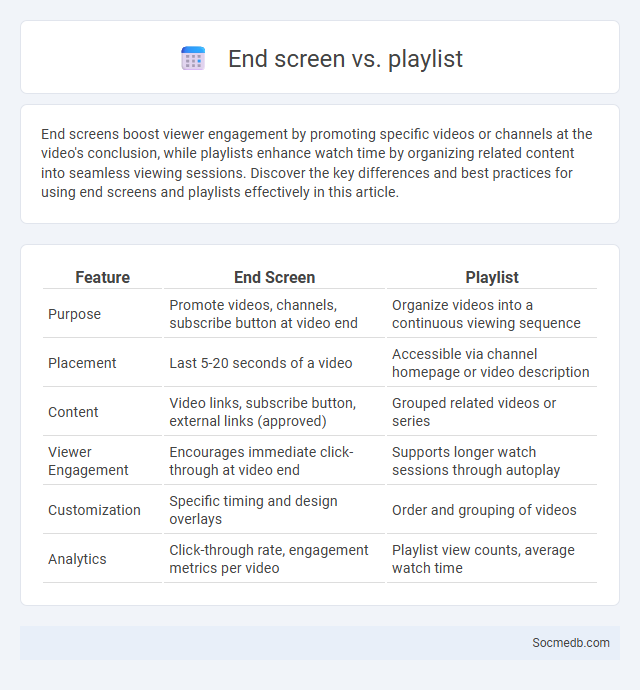
Photo illustration: End screen vs Playlist
End screens boost viewer engagement by promoting specific videos or channels at the video's conclusion, while playlists enhance watch time by organizing related content into seamless viewing sessions. Discover the key differences and best practices for using end screens and playlists effectively in this article.
Table of Comparison
| Feature | End Screen | Playlist |
|---|---|---|
| Purpose | Promote videos, channels, subscribe button at video end | Organize videos into a continuous viewing sequence |
| Placement | Last 5-20 seconds of a video | Accessible via channel homepage or video description |
| Content | Video links, subscribe button, external links (approved) | Grouped related videos or series |
| Viewer Engagement | Encourages immediate click-through at video end | Supports longer watch sessions through autoplay |
| Customization | Specific timing and design overlays | Order and grouping of videos |
| Analytics | Click-through rate, engagement metrics per video | Playlist view counts, average watch time |
Introduction to End Screen and Playlist Features
End Screen and Playlist features on social media platforms enhance content engagement by guiding viewers to related videos, increasing watch time and subscriber growth. You can customize End Screens to display video thumbnails, subscribe buttons, or links to external sites within the last 5-20 seconds of your video. Playlists organize your videos into thematic collections, making it easier for viewers to discover and binge your content, thereby improving overall channel visibility and retention.
What is an End Screen on YouTube?
An end screen on YouTube is a customizable feature that appears during the last 5-20 seconds of a video, designed to promote other content and encourage viewer engagement. It typically includes elements like video or playlist links, subscribe buttons, and external website links, enhancing channel visibility and increasing watch time. By using end screens, creators can strategically guide viewers toward related videos, boosting overall channel growth and audience retention.
Understanding YouTube Playlists
YouTube playlists organize videos into curated collections that enhance content discovery and viewer engagement. By grouping related videos, playlists improve watch time and channel visibility, making it easier for your audience to find and consume themed content. Optimizing playlist titles and descriptions with relevant keywords boosts search rankings and drives targeted traffic to your channel.
Key Differences Between End Screens and Playlists
End Screens on social media platforms serve as interactive elements that guide viewers to take specific actions, such as subscribing or watching another video, appearing in the last 5-20 seconds of a video. Playlists organize content thematically, allowing viewers to watch videos sequentially, enhancing user engagement through curated viewing experiences. Your strategy should leverage end screens for direct calls-to-action while using playlists to increase session duration and content discoverability.
Benefits of Using End Screens
End screens on social media platforms significantly increase viewer engagement by encouraging users to watch more content, subscribe, or interact with targeted links. They improve retention rates by guiding audiences towards relevant videos or playlists, enhancing the overall user experience and channel growth. By strategically placing calls-to-action, end screens boost conversion rates and help creators maximize the impact of their content marketing strategies.
Advantages of Implementing Playlists
Implementing playlists on social media enhances content discoverability by organizing videos or posts into thematic groups, increasing viewer retention and engagement. Playlists promote extended watch time by automatically playing related content, which boosts algorithmic favorability and organic reach. Brands and influencers benefit from playlists by providing a structured user experience that encourages repeated visits and deeper audience connection.
Comparing Engagement: End Screens vs Playlists
End screens on social media videos typically drive higher immediate engagement by prompting viewers to take specific actions such as subscribing or watching another video. Playlists enhance long-term engagement by organizing content into cohesive series, encouraging continuous viewing and increasing watch time. Analyzing viewer retention metrics reveals that end screens excel in call-to-action conversion rates, while playlists improve overall channel session duration.
Best Practices for Combining End Screens and Playlists
Optimizing end screens by linking relevant playlists significantly increases viewer retention and session time on social media platforms such as YouTube. Utilizing end screen elements to showcase curated playlists encourages binge-watching, enhancing algorithmic recommendations and channel growth. Implementing consistent branding and clear calls-to-action in these end screens ensures higher click-through rates and subscriber conversion.
Common Mistakes to Avoid with End Screens and Playlists
Common mistakes with end screens include cluttering the area with too many elements, which overwhelms viewers and reduces click-through rates. Failing to link relevant playlists can interrupt viewer engagement and decrease total watch time on your channel. Properly optimizing end screens by using clear calls-to-action and strategically placing playlists enhances viewer retention and overall channel performance.
Conclusion: Choosing the Right Strategy for Your Channel
Selecting the right social media strategy depends on your target audience, platform algorithms, and content goals. Analyzing engagement metrics, audience demographics, and competitor approaches helps tailor your tactics effectively. Consistent evaluation and adaptation ensure sustained growth and optimal channel performance.
 socmedb.com
socmedb.com